Project Management ( Part 2 )
Cost and Time Estimation
Is a trade-off, balancing the benefits of better accuracy against the costs of secured increased accuracy.
Types of Estimates
Top-down (macro) estimates
- Analogy
- Group consensus
- Mathematical relationships
Bottom-up (micro) estimates
- based on estimates of elements found in the work breakdown structure
Why Estimating Time and Cost Is Important
- To support good decisions.
- To schedule work.
- To determine how long the project should take and its cost.
- To determine whether the project is worth doing.
- To develop cash flow needs.
- To determine how well the project is progressing.
different aspects of estimating
- Range
- Accuracy
- Precision
- Confidence
Factors Influencing the Quality of Estimates
- Planning Horizon: cost estimates for a party you are organizing this weekend should be much more accurate than the estimates for a party that will take place in six months.
- Project Complexity
- People: How familiar are they with the task they are estimating?
- Project Structure and Organization: In a matrix environment may take longer, since attention is divided and coordination demands.
- Padding Estimates: Most of us are inclined to add a little padding to reduce the risk of being late
- Organizational Culture
- Others: Equipment downtime, National holidays, vacations, etc.
Estimating Guidelines for Times, Costs, and Resources
- Responsibility: estimates should be made by the person(s) most familiar with the task.
- The use of several people to estimate: leads to consensus and eliminate extreme estimate errors
- Normal conditions: based on certain assumptions. Estimates should be based on normal conditions, efficient methods, and a normal level of resources
- Time units: All task time estimates need consistent time units. Eg: calendar days, workdays, workweeks, person days, single shift, hours, minutes, etc.
- Independence: treat each task as independent of other tasks. To avoid some rough “guesstimate” of the total time for the whole path
- Contingencies: Work package estimates should not include allowances for contingencies.
- Risk assessment: to avoid surprises to stakeholders. Simply identifying the degree of risk
Top-Down versus Bottom-Up Estimating
Top-Down Estimates
- Are usually derived from someone who uses experience and/or information to determine the project duration and total cost.
- Are sometimes made by top managers who have very little knowledge of the component activities used to complete the project.
Bottom-Up Estimates
- Can take place after the project has been defined in detail.
- Can serve as a check on cost elements in the WBS by rolling up the work packages and associated cost accounts to major deliverables.
- Provide the customer with an opportunity to see various trade-offs in different project scenarios, such as time, cost, resources, and technical performance.
The Preferred Approach in Defining the Project
- Make rough top-down estimates
- Develop the WBS/OBS
- Make bottom-up estimates
- Develop schedules and budgets
- Reconcile differences between top-down and bottom-up estimates
Methods for Estimating Project Times and Costs
Top-Down Approaches
- Consensus Method: use experience of senior and/or middle managers to estimate
- Ratio Method: use number of square feet to estimate the cost and time to build a house
- Apportion Method: an extension to the ratio method. Foundation might represent 3% of the total loan, framing 25%, plumbing and heating 15%, etc.
- Function Point Methods for Software and System Projects: using a regression formula derived from data of past projects
- Learning Curves: The time to perform a task improves with repetition
Bottom-Up Approaches
- Template Method: If the project is similar to past projects.
- Parametric Procedures Applied to Specific Tasks: a cost of $7 per square yard of wallpaper.
- Range Estimating: Require three time estimates—low, average, and high (probability distributions). Get risk level from (high - low)
A Hybrid: Phase Estimating
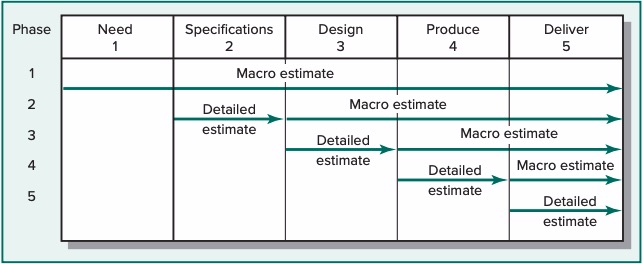
Level of Detail
A frequent rule of thumb used by practicing project managers says that a task duration should not exceed 5 workdays or at the most 10 workdays, if workdays are the time units used for the project.
Types of Costs
- Direct costs
- Labor
- Materials
- Equipment
- Other
- Direct project overhead costs
- salary of the project manager
- temporary rental space for the project team
- supplies
- specialized machinery
- General and administrative (G&A) overhead costs
- Advertising
- accounting
- salary of senior management above the project level
Refining Estimates
Reasons for adjusting estimates
- Interaction costs are hidden in estimates: each task estimate is supposed to be done independently. However, tasks are rarely completed in a vacuum.
- Normal conditions do not apply: availability of resources. Resource shortages, whether in the form of people, equipment, or materials.
- Things go wrong on projects: extreme weather conditions occur, accidents happen
- Project scope and plans change.
- People are overly optimistic.
- People engage in strategic misrepresentation: promoters underestimate the costs of projects and overestimate project benefits in order to win approval.
Creating a Database for Estimating
Collect and archive data on past project estimates and actuals
Mega Projects: A Special Case
A “white elephant” suggests a valuable, but burdensome, possession, which its owner cannot easily dispose of and whose cost (particularly upkeep) is out of proportion with its usefulness.
The Reference Class Forecasting (RCF)
Three Major Steps:
- Select a reference class of projects similar to your potential project.
- Collect and arrange outcome data as a distribution. Create a distribution of cost overruns as a percentage of the original project estimate (low to high).
- Use the distribution data to arrive at a realistic forecast. Compare the original cost estimate for the project with the reference class projects
Benefits:
- Outside empirical data mitigates human bias.
- Politics, strategic, and promoter forces have difficulty ignoring outside RCF information.
- RCF serves as a reality check for funding large projects.
- RCF helps executives avoid unsound optimism.
- RCF leads to improved accountability.
- RCF provides a basis for project contingency funds.
Developing a Project Schedule
Developing the Project Network
- Is a graphic flow chart depicting the project activities that must be completed, the logical sequences, the interdependencies of the activities to be completed, and the times for the activities to start and finish along with the longest path(s) through the network—the critical path.
- Provides the basis for scheduling labor and equipment.
- Enhances communication among project stakeholders.
- Provides an estimate of project duration.
- Provides the basis for budgeting the cash flow.
- Identifies which activities are “critical” and should not be delayed.
- Highlights which activities to consider for compressing the project duration.
- Helps managers get and stay on the project plan.
From Work Package to Network
Project networks are developed from the WBS. The project network is a visual flow diagram of the sequence, interrelationships, and dependencies of all the activities that must be accomplished to complete the project.
Constructing a Project Network
Terminology
- Activity: an element of the project that requires time but may not require resources
- Parallel activities: activities that can take place at the same time, if desired.
- Burst activity: an activity that has more than one activity immediately following it (more that one dependency arrow flowing from it)
- Merge activity: an activity that has more than one activity immediately preceding it (more than one dependency arrow flowing to it)
- Path: a sequence of connected, dependent activities
- Critical path: the path with the longest duration through the network
Two approaches
- Activity-on-Node (AON) uses a node to depict an activity.
- Activity-on-Arrow (AOA) uses an arrow to depict an activity.
Basic Rules to Follow in Developing Project Networks
- Networks flow typically from left to right.
- An activity cannot begin until all preceding connected activities have been completed.
- Arrows on networks indicate precedent and flow and can cross over each other.
- Each activity should have a unique identification number.
- An activity identification number must be greater than that of any activities that precede it.
- Looping is not allowed.
- Conditional statements are not allowed.
- Where there are multiple starts, a common start node can be used to indicate a clear project beginning on the network. Similarly, a single project end node can be used to indicate a clear ending.
Activity-on-Node (AON) Fundamentals
- Which activities must be completed immediately before this activity? These activities are called predecessor activities.
- Which activities must immediately follow this activity? These activities are called successor activities.
- Which activities can occur while this activity is taking place? This is known as a concurrent or parallel relationship.
Network Computation Process
Forward Pass—Earliest Times
- How soon can the activity start? (early start—ES)
- How soon can the activity finish? (early finish—EF)
- How soon can the project finish? (expected time—TE)
Backward Pass—Latest Times
- How late can the activity start? (late start—LS)
- How late can the activity finish? (late finish—LF)
- Which activities represent the critical path? (critical path—CP)
- How long can the activity be delayed? (slack or float—SL)
Forward Pass Computation
- Add activity times along each path in the network (ES + Duration = EF).
- Carry the early finish (EF) to the next activity where it becomes its early start (ES) unless…
- The next succeeding activity is a merge activity, in which case the largest early finish (EF) number of all its immediate predecessor activities is selected.
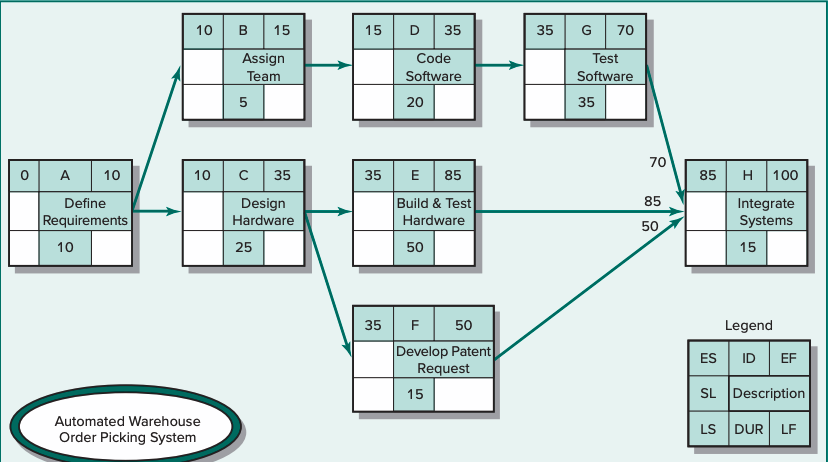
Backward Pass Computation
- Subtract activity times along each path starting with the project end activity (LF – Duration = LS).
- Carry the late start (LS) to the next preceding activity where it becomes its late finish (LF) unless…
- The next succeeding activity is a burst activity, in which case the smallest late start (LS) number of all its immediate successor activities is selected.

Determining Slack (or Float)
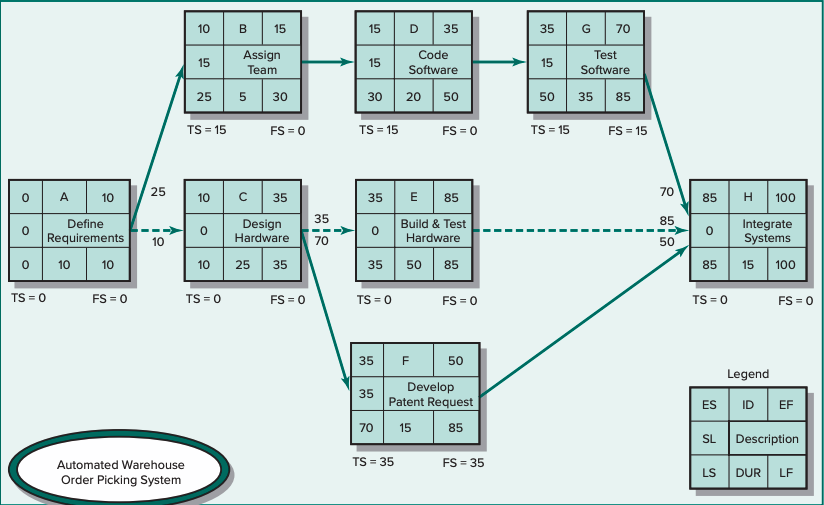
Total Slack
- Tells us the amount of time an activity can be delayed and not delayed the project.
- Is how long an activity can exceed its early finish date without affecting the project end date or an imposed completion date.
- Is simply the difference between the LS and ES (LS – ES = SL) or between LF and EF (LF – EF = SL)
Free Slack (Float)
- Is the amount of time an activity can be delayed without delaying any immediately following (successor) activity.
- Is how long an activity can exceed its early finish date without affecting the early start dates of any successor(s).
- Allows flexibility in scheduling scarce resources.
- Occurs only activity at the end of a chain of activities, where you have a merge activity
The Critical Path
- Is the network path(s) that has (have) the least slack in common.
- Is the longest path through the activity network.
- Is the shortest expected time in which the entire project can be completed.
- Is important because it impacts completion time.
- Is where you put best people on.
- Is where you pay extra attention when doing risk assessment.
- Is where you don’t look when other managers are asking to ‘borrow’ people or equipment.
- Is where you look when you don’t have time to monitor all activities
Sensitivity
- Network sensitivity is the likelihood the original critical path(s) will change once the project is initiated.
- A network schedule that has only one critical path and noncritical activities that enjoy significant slack would be labeled ‘insensitive’.
Practical Considerations
- Network Logic Errors: no Looping, no conditional statements.
- Activity Numbering: biger and biger, no repeat
- Use of Computers to Develop Networks (and Gantt Chart)
- Calendar Dates
- Multiple Starts and Multiple Projects: using a common start and end node helps to identify the total planning period of all projects
Extended Network Techniques to Come Closer to Reality
Laddering
Activities are broken into segments so the following activity can begin sooner and not delay the work.
Use of Lags to Reduce Schedule Detail and Project Duration
Finish-to-Start Relationship

Start-to-Start Relationship
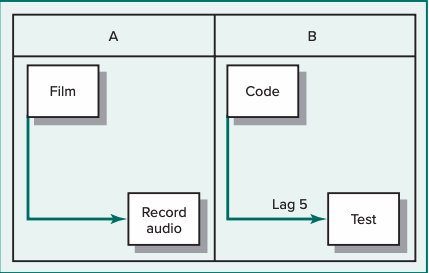

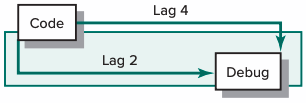
Hammock Activity
- Spans over a segment of a project.
- Has a duration that is determined after the network plan is drawn.
- Is very useful in assigning and controlling indirect project costs.
- Is used to aggregate sections of the project to facilitate getting the right level of detail for specific sections of a project.

Project Management ( Part 2 )
https://kongchenglc.github.io/blog/2024/10/24/About-Project-Management-Part-2/